Mar 13, 2020 | News |
Abbie Hunt Contributing Writer
Sophomore Kolby Boulgier and Freshman Brenna Saucier are replacing their exams in PSY 235: Introduction to Counseling with the experience of mentoring elementary school students. Boulgier is mentoring a young girl through the Lunch Buddy program and at W.G. Mallett Elementary School once a week and Saucier is taking a different route and mentoring a little boy at the pool every week.
Dan Seabold, a professor of psychology and the Intro to Counseling class instructor, encourages students to use volunteering in the Mount Blue School system as an opportunity to practice the skills they are learning in class. “I have always believed that it’s important for students to gain professional experience,” he said. “We can’t build confidence without real experience.”
Seabold allows students to use their mentoring experience as a grade booster or extra credit. “[Students] can use the grade from this to replace an exam,” he said.
He believes that the application of working with real people is more beneficial than just remembering information for a test. “Application helps with retaining skills and knowledge,” he said. He requires students who are choosing to mentor a student through a program such as the Lunch Buddies to keep a reflection journal on their own insights and questions.
Not only is this helping psychology students gain real life experience, they are making a difference in a child’s life in addition to helping them grow. “It gives these kids a sense of self-esteem and value,” Seabold said. “It gives them developmental assistance in a non-threatening way,”
Seabold sees the impact of this mentorship in the way the kids look forward to meeting with their mentors. “They want their mentor,” he said. It makes other students who do not have a mentor also want one.
When Boulgier first heard that participating in the Lunch Buddy program could be an exam replacement, she applied to be a Lunch Buddy through the Mallett Elementary School. “I didn’t hear [back] for four weeks,” she said. “I was very nervous I would have to take an exam.”
Boulgier laughed and put her hands to her face as she explained her first encounter with a group of elementary school teachers. “I went to the second floor and instead of turning right, I went straight,” she said. “I walked past a room full of teachers.” She ended up having to interrupt a meeting to ask for directions to her buddy’s classroom.
When Boulgier finally met the student she would be mentoring, there was an instant liking to one another. “She’s adorable,” she said. “She’s like me when I was a kid.”
After the introductions, Boulgier and her buddy set out for the cafeteria to eat lunch, where they met more enthusiastic and eager Mallett students. “They were telling stories to me non-stop,” Boulgier said. “They were so excited and they kept talking about Minecraft.”
At recess, the young girl led Boulgier around the playground to show her the slides and monkey bars. “You’re making bonds with kids, and they’re going to tell you everything,” Boulgier said.
Instead of mentoring a student through the Lunch Buddy program, Saucier got permission to work with a young boy taking swimming lessons at the pool because it fit into her schedule better, and as she already a certified Water Safety Instructor. “It is very nice to take an hour a week and just separate from the world to work with a kid,” she said in an email interview. “He and his parents were some of my favorite people so they wanted to continue lessons and then we coordinated doing this project. He is one of the cutest kids I know.”
Saucier wants to be a good influence on the boy, and she appreciates watching him gain more confidence as she works with him on different skills. “He is super sweet and is so active. He is always happy and can always make himself laugh and I am fascinated by him,” she said.
To become a Lunch Buddy and learn more about the program, go to http://getconnected.volunteermaine.org/agency/detail/?agency_id=56936.
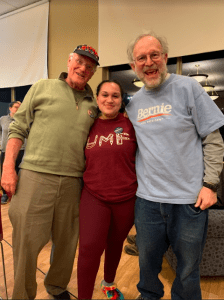
Mar 13, 2020 | News |
Brooke Valentin Contributing Writer
In the midst of Bernie Sanders’ presidential campaign, popular ice cream makers Ben Cohen and Jerry Greenfield, of Ben and Jerry’s, recently visited campus to host an ice cream social in support of Sanders’ campaign.
The event was hosted by the UMF College Democrats in the Landing. Kurtis Morton, Democrats president, was contacted by Representative Ben Collings, of Maine District 42, who is the head of Sanders’ campaign in Portland, about hosting an ice cream social for students to learn more about the campaign. “Ben emailed me last minute and asked if we would be interested in hosting an ice cream social about Bernie Sanders campaign,” Morton said. “We thought it would be a good idea for Bernie supporters.”
Collings kicked off the social by discussing his role in the campaign and its importance to him before introducing Cohen and Greenfield. Cohen said, “Before Bernie, Jerry and I used to be the most famous guys from Vermont, but we’re really happy to turn that title over to Bernie. Ice cream is good but a President of the United States who truly believes in justice in all its flavors is euphoric.”
Ben and Jerry’s has become well known as a politically motivated company, both Cohen and Greenfield having been arrested at a Democracy Spring protest in April 2016, rallying against the influence of money in politics. Their website outlines a variety of issues the company has stances on including climate justice, refugees, LGBTQ+ rights, racial justice and GMO labeling.

Brooke Valentin with Ben and Jerry. Photo Courtesy of Brooke Valentine.
Though the Ben and Jerry’s company claims no political affiliations, both Cohen and Greenfield are loud and proud about their personal support for Sanders, the ice cream being only a courtesy. “I’ve been thinking lately about the Pledge of Allegiance strangely enough. It’s something we all said everyday in public school. The pledge ends with ‘and justice for all,’” Cohen said at the social. “It’s about equality and fairness, but then you get out into the real world and realize that this isn’t true. Bernie believes in justice for all, he believes that the country should be based on love, compassion and generosity.”
Greenfield then took the mic to talk about the importance of voting. He said, “A whole bunch of people who don’t normally vote in democratic primaries have to get out and vote in democratic primaries.”
According to an article by the Pew Research Center, as of Nov. 2016 there were about 245.5 million people in the U.S. of voting age, but only 157.6 million who were registered. To impress the importance of getting out and voting, Cohen urged students at the social to consider their priorities come election day, that they may have weigh going on a date over going to the booth. But when one student called from the crowd, “Bring your date to the booth!” Cohen called back, “Yes! Bring your date to the booth! Do it in the booth for Bernie!”
“It’s wonderful to see all of you here and to feel the energy here. This is what it’s going to take to bring about a political revolution,” Greenfield said. “There’s nothing Ben and I would rather do then come out and scoop ice cream for Bernie supporters.”
Students interested in the College Democrats can find the club at meetings every Tuesday from 6 p.m.-7 p.m. in the Roberts room 103, or follow the club on Instagram @umfdems.
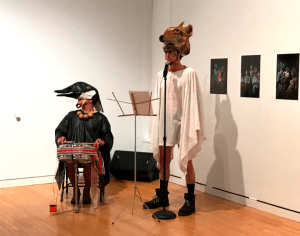
Feb 28, 2020 | News |
Taylor Burke, Contributing Writer
The VOYAGER: Migrational Narratives exhibit introduces a conversation on migration to the UMF community through various mediums and perspectives. The exhibit, which is free to the public, opened from Jan. 30 to March 6.
Olivia Donaldson and Ann Bartges, curators of the exhibit, recently opened the gallery on a night that included live performances and virtual reality experiences. The exhibit features paintings, collages, photographs, textiles, sculptures, a poem and digital media pieces that viewers can watch and listen to. Each piece explores what it means to migrate and highlights experiences and perspectives on migration.
Donaldson, a French professor, has been researching migration and teaches global studies. She is passionate about migration and interested in the arts. Bartges is the director of the Emery Community Arts Center and a professor of visual arts.
Donaldson and Bartges were friends prior to the project which aided their collaboration. They began conversing about migration over a poem that became part of the exhibit. “In some ways, the poet launched the conversation between Olivia and I a long time ago,” Bartges said, “the poem kind of started the whole idea of the exhibition.” Bartges proposed the idea of the exhibit to Donaldson in her efforts to find ways that Emery could serve the rest of the campus, not just the art department.
The whole project took about a year to complete. “I don’t know if either of us really mapped that out when we started this,” Bartges said laughing with Donaldson. With Bartges’ background in art and Donaldson’s vision for interdisciplinary work, the two complemented each other in the curation process.

Arturo Herrera (left) and David Sanders (right) perform at the opening night for the VOYAGER exhibit. Photo Courtesy of Ann Bartges.
Donaldson and Bartges put out a call for submissions and were presented with a strong pool of pieces. “The works by artists who had experienced migration first hand had so much more depth,” said Bartges. “Those works just tended to have more layers,” she said.
Bartges and Donaldson’s decisions were influenced by their vision for the exhibit and tone they wanted to set. “We really didn’t want the show to become a binary conversation about whether migration is good or bad,” Donaldson said. “We wanted the show to be about connections.”
Bartges found Nayda Cuevas’ piece, “Adios: Puerto Ricans Always in Migration” to capture the tone they wanted for the exhibit. “We wanted to show this really human part of the migration experience,” she said.
This exhibit provides another perspective to understanding migration and its many facets. “We all engage with [migration] in newspaper headlines and in political language,” Bartges said. “But then there’s this other opportunity to engage in these issues through stories and narratives and experiences.”
One of the mediums, included only on opening night, was a virtual reality film called “A Shared Space: Lewiston,” created by documentary filmmaker Daniel Quintanilla and collaborators Shuab Mahat and Hilowle Aden. The film chronicles Mahat and Aden, two friends, who grew up in the Dadaab Refugee Camp in Eastern Kenya and currently live in Lewiston. “It looks at the challenges they each face in raising families in Maine during a time of rising nationalism, closed borders and travel bans,” Quintanilla said in an email.
The virtual reality experience allows viewers to immerse themselves in the content in ways other forms don’t allow for. “[A Shared Space: Lewiston] came out of a need to create content that could help others see and imagine the lives of others,” Quintanilla said.“We saw 360-degree cameras and headsets as a way to create virtual experiences in which we could invite viewers to enter spaces they might not be able to enter on their own.”
The creators of the film wanted to call attention to Maine’s connection with migration and the issues that surround it.“It’s too easy to be passive and think that families separated by ICE, borders, or policies is happening elsewhere,” Quintanilla said. “One of our goals is to highlight Maine’s relationship to global migration.”
This piece, like all of the others in the exhibit, is a way of storytelling and communicating human experiences. “I hope viewers are not only moved by the stories presented,” Quintanilla said in an email. “But can translate that empathy into action of some kind.”
Two of the pieces in the exhibit were created by creative writing professor, Éireann Lorsung. Her first work, “Completely out of Water,” is a collage piece from a series of 15 that she made during her time in Belgium.
Lorsung used this piece to play with English idioms while also channeling her own experience of being foreign. “What happens when you make an idiom literal?” she said. “What’s literally happening is very uncomfortable.” Although the literal meanings of idioms can cause discomfort, the piece was also supposed to evoke some humor due to the differences between the literal and metaphorical meanings of idioms.
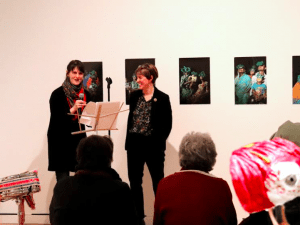
Curators Ann Bartges and Olivia Donaldson speak at the opening night of the VOYAGER exhibit. Photo Courtesy of Ann Bartges.
Lorsung’s second piece, “Royaume de lumière x 144,” is part of a series of 144 small paintings that document the land that she lived on and had to leave. There is also a sound bit that goes along with the piece and plays a recording of the sounds from her garden.
When Lorsung left Belgium she lost her sheep and garden, among other things. “There’s no clear way to live through that,” Lorgsung said. “Art is a way that I’m trying to understand all that stuff.”
All the objects in the paintings are drawn from memory in an effort to reclaim what can’t be reclaimed. “Basically all the work I do is really thinking about having been an immigrant and what it meant to leave,” she said.
As an immigrant herself, Lorsung has noticed that migration is generally demeaning despite it being a natural and historical occurrence. “It’s borders and boundaries that are the new thing,” she said. “Human migration is not a new thing.”
Arturo Herrera, who is based in the Detroit area, was the creator of “The National Bird” piece displayed at the exhibit. “The National Bird is an experimental performance series highlighting several migratory animal disguises,” Herrera said in an email. “It builds on the premise that wild creatures can legally cross territorial boundaries anytime and anywhere without checkpoints.”
“The National Bird” gave and still gives Herrera the opportunity to create work that tells his personal story while not being directly about him. The piece is not finished and continues to evolve and grow, much like the subject of migration. “The work provides a different perspective on issues of relevant concern like immigration,” he said.
Herrera attended the opening night of the show and performed using two characters from his series. “[M]y impression was great of the show, as well as how every work in the gallery was speaking with each other,” he said in an email.
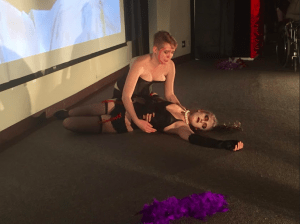
Feb 28, 2020 | News |
Portia Hardy Contributing Writer
The beloved UMF “Rocky Horror Picture Show” shadowcast is in danger of disappearing due to a lack of Student Senate Spring Fling funding. Head director, senior Chloe Woodward, and her directing team are fighting to surpass financial obstacles for at least one more show this spring.
“Rocky Horror might not happen next year,” said Woodard. “We have always received funding through the Spring Fling senate funding. [But] there is no Spring fling, that is confirmed.”
Choreographer Alexis Ramee, a junior, is concerned for the show’s usual charitable donations and new monetary stress placed on the cast. “. . .everything we raised as a group went straight to SAPARS (Sexual Assault Prevention and Response Services),” she said in an email interview. “Now that there is no Spring Fling any more, we, as a whole group, have to come together to raise money so we can get the costumes and props we need for the show.”
Woodward said cast members have had to dip into their own personal funds for supplies. “I’ve already spent over 200 dollars on getting to start the show. The cut of funding might mean that there is no more Rocky.”
Rocky Horror has been shown at UMF for about 10 years now as a shadowcast, where actors and dancers perform on stage with the movie playing on screen behind them. Shadowcast origins trace back to the film’s release in the 1970’s, as does its reputation as a cult-classic.
“Rocky Horror is a movie that was made in the 70’s that didn’t do good at all when first released so they then moved it to the midnight showings,” Ramee said in her email, disclosing a brief history of the show. “By doing that only a select few people could even watch it but it was those people that got stuck on it. That’s how the ‘cult’ part all started,” she said. “It influences today’s viewers because a lot of us go in knowing what the call lines are or even what the purpose of the movie as a whole was. Even people who haven’t seen it or haven’t immersed themselves within this culture come out of the woodworks to see the UMF production. The cast members are the audience members as well.”
Senior Darby Murnane has been involved with Rocky for three years now, playing lead roles like Janet and Frank-N-Furter. This year, on the directing team, her current title is “Helping Princess,” she said.
“[Rocky] is an erotizised paradody of ‘Frankenstein,’ in which our Dr. Frank-N-Furter, our Frankenstein copy, is building himself a lover instead of a monster, and the deep subplot is he’s going to build multiple lovers and sell them off for profit,” said Murnane.
The show is unique for the audience participation in call-lines, developed by early audiences who saw midnight showings on a regular basis. The audience often yells, “Asshole!” and “Slut!” at characters Brad and Janet, a newly engaged couple.
The plot follows Brad and Janet as they stumble across Dr. Frank-N-Furter’s mansion one dark night looking for a telephone to use, “and then everything goes wrong,” Murnane explains.
The show’s rich history of traditions is the cast’s responsibility to uphold. “It carries a lot of weight, the call lines created a forced interaction and participation with the film,” Murnane said. “It’s not really a zone-out show, because there’s so much happening, you really have to be in on it. It’s primarily a cult of the LGBTQ community and the torch gets passed along from cast to cast to uphold the culture there.”
Ramee and Murnane hold out hope that someone will take over the show to keep it alive on campus next year. “I do hope a club will come and start doing Rocky. It will be very sad to see it end. But if this is the end, then you should be damn sure we are going out with a bang,” Ramee wrote.
The directors are prioritizing the survival of the family-oriented nature of the cast. “The Rocky cast really is a family for the people that are in it and I would like to see that continued for people who really need that in the way that I needed it and still do. I found Rocky when I was struggling and it saved my life in more ways than one,” Murnane said.
In Woodward’s time as assistant director and now leader, she’s seen what the Rocky family means. “There’s been so many people that come up to me after the show and say, ‘Wow, you guys really helped me through all these hard times,’” she said. “One of our biggest things is consent, it really helps people who have struggled with sexual assault.”
“It’s a day where people can just be themselves without fear of judgment or cruelty,” said Ramee.
Those interested in helping can donate to the cast or Woodward’s GoFundMe page.
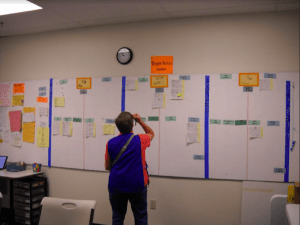
Feb 17, 2020 | News |
Andrea Swiedom Staff Reporter
Last February, Professor of History Anne Marie Wolf sat traumatized before the TV while images flashed across the screen of children, who had just fled the horrors of their homes and crossed the U.S.-Mexico border, sat on bare concrete warehouse floors trapped in chain link cages.
“I was watching T.V. and getting more and more upset about it and I ended up applying that night [to be a volunteer].” Wolf is fluent in Spanish and applied for a volunteer position in El Paso, Texas at the Annunciation House which provides necessities to newly arrived Central American migrants.
The Annunciation House has provided aid to migrants since 1978 and the program has seen a dramatic spike in numbers during the Trump Administration, which has released a series of new border policies in the past three years. Just between Oct. 2018 and April 2019, according to one Washington Post article, the Annunciation House received 50,000 migrants, and projected estimates only continued to rise. As of December, the House said that they take in an average of 100 people per day.
The U.S. Customs and Border Protection (CPB) saw a total of 101,774 migrants apprehended at points on the Southwest border at the end of 2019, according to their website, as well as 26,681 migrants deemed inadmissible.

The boards used for coordinating migrants with sponsor families. (Photo courtesy of Dr. Wolf)
In July 2017, the Department of Homeland Security (DHS) launched a pilot program in the El Paso, Texas sector authorizing border patrol to separate children from their guardians if they had entered the U.S. illegally.
There were 8,000 separated families, said a report from Amnesty International, by the time this policy was overturned on June 20, 2018. Just a few months prior, Attorney General Jeff Sessions announced the still current Zero-Tolerance Policy permitting criminal prosecution of anyone crossing the border illegally, regardless of their reasons for making the journey. This was previously a misdemeanor for first-time offenders.
The new policy combined with additional measures from the Trump Administration has resulted in migrants camping out in tent compounds for several months, even a year, as they file asylum paperwork in border towns such as Matamoros, Mexico, on the other side of Brownsville, Texas. These tent compounds pose both a humanitarian and security risk as thousands of people try to maintain a consistent food source, sanitation and ward off human traffickers.
“Nobody would do this, uproot themselves and hang out in a tent on concrete for a year and half,” Wolf said. Those that do cross the border face immediate arrest and are sent to remote detention centers to face prosecution.
“They put these detention centers out in the middle of nowhere because it’s out of sight, out of mind, which makes it difficult because attorneys don’t live in the middle of nowhere,” Wolf said while looking at an aerial photograph on Google of the Stewart Detention Center–an oddly shaped complex in a dense forest 140 miles southwest of Atlanta, GA. “How many immigration attorneys are living out there?”
If migrants are released from these centers, or are fortunate to bypass this step and immediately deemed candidates for asylum by U.S. Immigration and Customs Enforcement (ICE), they end up at places such as the Annunciation House where volunteers connect them with their sponsor families, provide food, clothing, shelter, transportation money and advice for their next steps.
The average stay for migrants at the House is 36 hours, during which volunteers like Wolf make phone calls to track down sponsor families to support people through the asylum application process. Volunteers also provided what Wolf described as basic hospitality and travel assistance.

Artwork from children from Dr. Wolf’s time working in the Annunciation House. (Photo courtesy of Dr. Wolf)
“For a lot of people it was the first time they had been in an airport or seen an escalator. The El Paso airport is not a big airport, but not speaking the language and everything…we were just helping them navigate,” Wolf said. “There’s a special line for you to go through if you’ve been released through ICE and we would explain that you’re going to be patted down, you’re not going to be arrested.”
When Wolf returned to Farmington, she began providing translation services to pro bono attorneys working with migrants in detention centers.
“Now I am getting deeper into the reasons why these people were leaving. The gang violence is just out of control, people have had their children killed and raped in front of them, they’ve had dead bodies dumped on their doorstep and told, ‘you’re next.’”
Over the phone, Wolf translates intake interviews between attorneys and detainees to gather their reasons for fleeing their countries. She will sit late at night in her office translating court documents and feeling the weight of each person’s life.
“If they get sent back, they have a pretty good chance of being killed,” Wolf said. “The gangs are really organized and they’re organized across national lines. They know if someone has moved and moved in with their sister in another part of the country because they have their affiliates that are looking for that person.”
Each case comes with an emotional toll, but this has not deterred Wolf from continuing to offer her services. “In the summer I will probably be going somewhere to volunteer.”
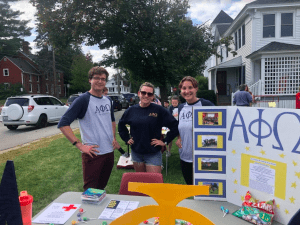
Feb 17, 2020 | News |
Kathleen Perry Contributing Writer
Students looking for community service opportunities and a touch of college Greek life can look no further than Alpha Phi Omega (APO) which strives to create a community focusing on their main principles: “leadership, friendship, and service.” APO, UMF’s co-ed community service organization, is looking to accept new members into their fraternity, and are on the lookout for students who want to meet new people and serve the campus and Farmington area.
They are a wide-reaching and well respected national organization, that has chapters on many campuses throughout the country including the University of New Hampshire, University of Vermont, and Maine Maritime Academy. APO was established 1991 and has around 500,000 members.

APO Members Kaden Pendleton, Emily Thibodeau, Piper Alexander (Photo courtesy of Madison Vigeant)
APO President Madison Vigeant and APO Vice President Haley Knowlton, both juniors at UMF, agree that the personal connections they have made through the organization go beyond just doing community service, and they feel as though the group has become like a family. To achieve these bonds, once a week the club holds “fellowship,” for the members to spend quality time together through low pressure activities, such as paint nights, movie nights, or, more recently, a snow tubing trip.
The organization also attends conferences out of state. “We’ve gone to Texas, Massachusetts, New Hampshire, and at the end of this year we are going to Arizona,” says Elizabeth Leclerc, senior and general member of APO.
One of APO’s most successful events was a bake sale through the United Way in order to benefit victims of the LEAP building explosion in Sept. 2019, taking the life of Captain Michael Bell and affecting the Farmington community. Knowlton said customers would “buy a brownie for fifty cents and hand you a twenty [dollar bill].”
With many community members pitching in to help, the fundraiser made almost $800.
Members of APO join for many reasons. For Vigeant, community service has been a constant in her life for years. “In high school, I was really into community service,” she said. For others, they join to gain skills that will help them in the future.
“APO has helped me to expand my horizons in leadership roles, learn more about community service, and has helped me with organization skills,” says Leclerc.
If students want to get involved with a group that helps out the community, while making lifelong friends, they should attend the first new members meeting on Feb. 10 at 7 p.m. in Ricker Addition 217. While being sworn into the group, each new participant will be paired with a mentor based off of a compatibility test. Throughout each person’s time in the club, they must meet up with their mentor at least once a week in order to keep the connection, and to discuss the community service they are doing, of which APO requires 15 hours per semester.
Vigeant and Knowlton say that if someone is considering joining, they can go to the first meeting and if they don’t like it, they don’t have to stay. “We are very open and friendly and we like meeting new people” says Vigeant.






